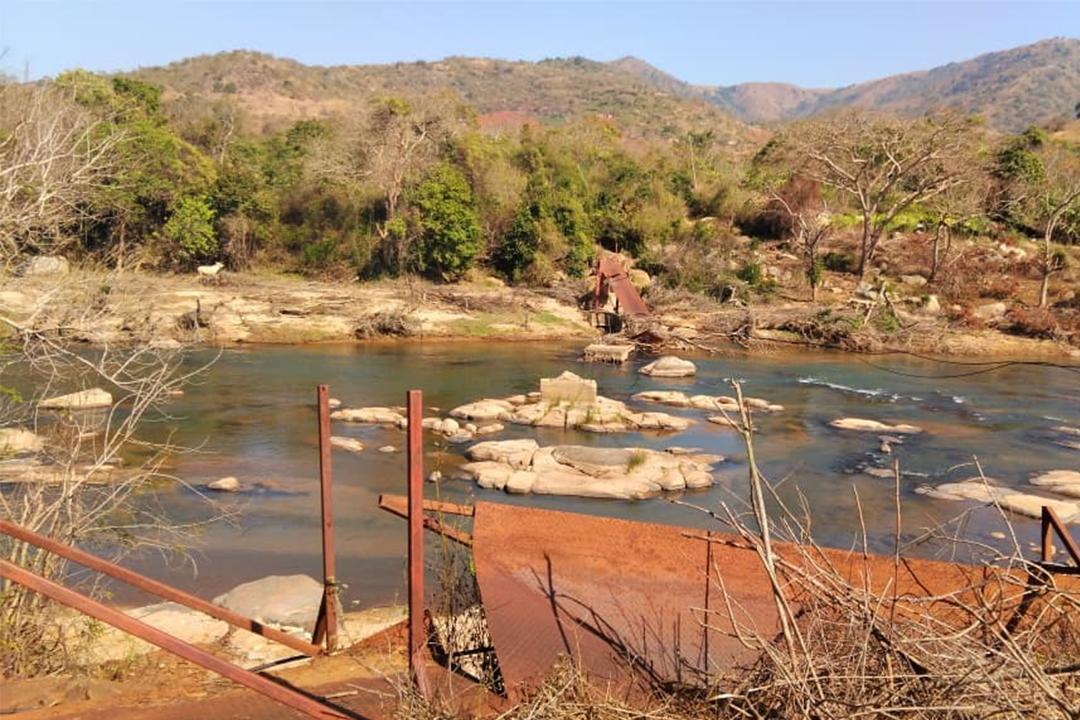Africa-Press – Eswatini. In the wake of the devastating floods that struck Eswatini in January 2025, Engineers in Action (EIA) and the Microprojects Programme have officially launched the construction of the Luphandzane Suspension Bridge in Mkhitsini, Shiselweni 11 Inkhundla.
The January floods, triggered by intense rainfall and the unexpected opening of dams in South Africa, caused unprecedented damage to infrastructure across the country. Bridges were washed away, homes destroyed, and entire communities cut off from essential services.
During flood consequences surveys along the Mkhondvo River, EIA and Microprojects teams witnessed the devastating power of the torrents. Several bridges were completely swept away overnight, leaving communities stranded for weeks.
One bright spot was the Masongwane Suspended Bridge, built by EIA in 2023, which withstood the floods with only minor damage. Quick repairs by the EIA team ensured it remained safe, becoming the only available crossing in the area for several months.
Further downstream, the destruction was severe. The Mikhitsini Bridge at SHiselweni II was completely washed away, making crossings impossible for several days in early January. During this time, the government responded by deploying the Umbutfo Eswatini Defence Force (UEDF) to deliver critical aid by air, ensuring that food and other essentials reached stranded communities.
The Deputy Prime Minister appealed to international partners for support and coordinated national disaster response measures to address the scale of the crisis.
One of the most dramatic moments of the floods came when 19-year-old Khayalethu Vilakati was swept into the raging waters of the Mkhondvo and forced to cling to a tree for four hours. In a daring rescue operation, the Eswatini Army deployed a helicopter to lift him to safety, underscoring the life-threatening conditions faced by residents along the riverbanks.
The final stop of EIA’s January survey was Mkhitsini, where the mention bridge had been completely washed away, leaving only debris scattered along the riverbank. With over 310 households isolated, access to schools, clinics, and markets was entirely cut off.
Recognizing the urgency, EIA and Microprojects decided to rearrange their 2025 construction schedule and make Mkhitsini the site of their final build of the year, hoping for Mkhondvo river to minimize its flow and make it crossable during the construction period.
On Monday August 18, 2025 work will begin on the Luphandzane Suspension Bridge, a climate-resilient structure designed to provide a permanent solution for the community. Scheduled for completion by October 15, the bridge is intended to be ready before the heavy rains return.
At 99.5 meters, the Luphandzane Suspension Bridge will be the longest of its kind built by EIA in Eswatini. Its design includes additional steel reinforcement, conservative setbacks, and a higher budget than typical suspension bridges.
The goal is to withstand even the highest flood levels recorded so far on the Mkhondvo River, though, as EIA notes, no one can predict the full force of future torrents.
“During the January survey, it was heartbreaking to see so many bridges washed away and so many people stranded,” said Ana Jovanovic, EIA Program Manager. “Our mission to provide safe, reliable access year-round has taken on new meaning. The floods showed just how critical pedestrian footbridges are, they can be the difference between life and death. We hope and pray that this bridge will serve the Mkhitsini community for many years to come, protecting their livelihoods from future floods.”
Siboniso Simelane, Technical Officer of Microprojects and lead engineer for the Luphandzane Bridge, added: “Working on this bridge is both a professional challenge and a personal mission. Being Swazi myself, I am proud to contribute to my community’s resilience. The January floods were devastating but seeing the Masongwane Bridge we built in 2023 still standing gave me hope.
What makes me especially proud and excited about this project is that, for the first time, EIA is directly responding to the consequences of a natural disaster,” he added. “It’s a serious and highly responsible task for the entire team, one that demands hours of overtime, top-level engineering skills, and a culture where we constantly hold each other accountable. With rivers like the Mkhondvo, there are no shortcuts. Every detail matters if we want to truly protect the people who live in this area.”
The Luphandzane project combines EIA’s bridge-building expertise with Microprojects’ experience in working with remote communities. As the last build of the year, the team is committed to completing it before the rainy season. Beyond providing physical access, the bridge will improve safety, enable economic activity, and ensure uninterrupted education and healthcare for Mkhitsini residents.
The Bigger Picture – Why This Work Matters
Floods devastate communities along Eswatini’s rivers every rainy season. For those living on riverbanks, rising waters can mean isolation for weeks, lost income, disrupted schooling, delayed medical care, and, in the worst cases, loss of life. Climate change is making these events more frequent and severe.
EIA’s work in Eswatini has long focused on connecting communities through safe pedestrian bridges, but the January 2025 floods marked a turning point. For the first time, EIA is directly responding to the consequences of a natural disaster, stepping into the role of emergency infrastructure responder.
By building climate-resilient bridges like Luphandzane, EIA and Microprojects are restoring connections, safeguarding lives, protecting livelihoods, and helping communities adapt to a changing climate. With Luphandzane being the final bridge in 2025 and the 36th bridge built in cooperation with EIA in Eswatini, the team starts construction on Monday August 18th, putting together all available resources, skills and their hearts into it.
For More News And Analysis About Eswatini Follow Africa-Press







